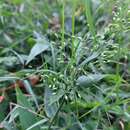tr
kırıntılardaki isimler


Panicum sabulorum, es una especie botánica, gramínea perenne rizomatosa, de la subfamilia de las Panicoideas.
Son plantas perennes corto rizomatosas. Los culmos dimórficos: tallos jóvenes simples, erguidos y con hojas amplias, cordadas y lanceoladas, tallos erectos a decumbentes los mayores, de vez en cuando con el enraizamiento y profusamente ramificación en los nudos inferiores y superiores, de hasta 1 m de largo, con las hojas más pequeñas que las de la sencilla cañas. Vainas de 2,5-6 cm de largo, hirsuto a glabra. Lígulas membranosa-ciliadas, 0,4-1,1 mm de largo; pilosa collar o glabras. Hojas lanceoladas, de 1-9 (-15) cm de largo, 0,2 a 1,4 (-2) cm de ancho, planas, cordadas sub a cordadas, amplexicaulous, acuminado, rígido para herbácea, pubescentes, con pelos cortos. Inflorescencias primarias laxas, difusas. Panículas axilares similares a la terminal, pero más pequeñas. Espiguillas obovoide, biconvexos, 1,9-3 mm de largo, 0,9 a 1,4 mm de ancho, stipitate mente corto, de color verdoso y teñida de púrpura, hirsuto a glabros; glumas y lema inferior con nervios manifiestos. Baja gluma 3-5-nervada,? 1 / 2- la longitud de la espiguilla. El fruto en forma de cariópside ampliamente elipsoide, de 1.5 mm de largo, 1 mm de ancho; puntiforme hilio; embrión menos de la mitad de la longitud de la cariópside.[1]
Panicum sabulorum fue descrita por Jean-Baptiste Lamarck y publicado en Encyclopédie Méthodique, Botanique 4(2): 744. 1798.[1]
Panicum: nombre genérico que es un antiguo nombre de latín para el mijo común (Setaria italica).[2]
sabulorum; epíteto latíno que significa " arena, o se refiera de alguna manera a la arena".[3]
Panicum sabulorum, es una especie botánica, gramínea perenne rizomatosa, de la subfamilia de las Panicoideas.
Panicum sabulorum adalah spesies tumbuhan yang tergolong ke dalam famili Poaceae. Spesies ini juga merupakan bagian dari ordo Poales. Spesies Panicum sabulorum sendiri merupakan bagian dari genus Panicum.[1] Nama ilmiah dari spesies ini pertama kali diterbitkan oleh Lam..
Panicum sabulorum adalah spesies tumbuhan yang tergolong ke dalam famili Poaceae. Spesies ini juga merupakan bagian dari ordo Poales. Spesies Panicum sabulorum sendiri merupakan bagian dari genus Panicum. Nama ilmiah dari spesies ini pertama kali diterbitkan oleh Lam..
Panicum sabulorum là một loài thực vật có hoa trong họ Hòa thảo. Loài này được Lam. mô tả khoa học đầu tiên năm 1798.[1]
Panicum sabulorum là một loài thực vật có hoa trong họ Hòa thảo. Loài này được Lam. mô tả khoa học đầu tiên năm 1798.